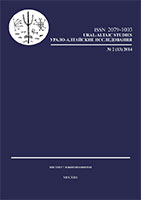Категории вида, времени и эвиденциальности в среднемонгольском языке
Aspect, tense and evidentiality in Middle Mongol
Author(s): Benjamin BrosigSubject(s): Language and Literature Studies, Theoretical Linguistics, Morphology, Syntax, Lexis, Semantics
Published by: Институт языкознания Российской академии наук
Keywords: Middle Mongol; aspect; tense; evidentiality; perfectivity; imperfectivity
Summary/Abstract: The paper contains an analysis of aspect, tense and evidentiality in Middle Mongol. This language has a fairly complex aspectual system, consisting of mostly periphrastic constructions built up from converbal, participial and final suffixes, and two different stative copula verbs. They express progressivity, habituality, genericity, perfectivity, perfect and resultativity on the present and past tense levels. Present progressivity and resultativity can both be expressed by two different constructions that differ by their aspectual scope and / or actional properties. The three past tense suffixes mark factual, firsthand and secondhand information. This evidential trichotomy is restricted to the perfective aspect, while all other aspectual past tense markers only receive firsthand or secondhand marking. No aspectual distinctions seem to be made in the future, though both the future participle and the resultative participle can form contrafactual constructions.
Journal: Урало-алтайские исследования
- Issue Year: 2014
- Issue No: 02 (13)
- Page Range: 007-038
- Page Count: 32
- Language: Russian

